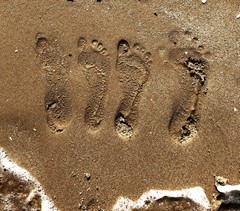 |
When the iPhone 15 and iPhone 15 Pro models were first announced, we looked at the features and specs to compare them. Now that we’ve shot with both a Pro and non-Pro iPhone, it’s time to revisit the 'camera that’s always with you' and see how they stand up against each other.
Are the new 24- and 48-megapixel resolutions in the iPhone 15 enough of an improvement over previous models that you can save money on an upgrade by not going Pro? Or do the additional features such as the macro mode, telephoto camera and raw format support justify the higher price of the iPhone 15 Pro?
After testing, we think the Pro is a clear choice for anyone who wants a camera first and foremost, but let's dig into the details.
Buy Now:
A quick look at the specs
You can dig deeper into the spec sheets if you're so inclined, but here's the gist. The current iPhone models come in two tiers. The entry level comprises the iPhone 15 and iPhone 15 Plus (the option with a larger screen). Both have two rear-facing cameras and one front-facing camera; the camera hardware is the same on both devices regardless of screen size.
The upper tier comprises the iPhone 15 Pro and iPhone 15 Pro Max (the larger-screen version), each with three rear-facing cameras and one front-facing camera. The Pro versions share the same camera hardware, with the exception of the telephoto lens that both models have but which is 3x (72mm equivalent) on the iPhone 15 Pro and 5x (120mm equivalent) on the iPhone 15 Pro Max.
"After testing, we think the Pro is a clear choice for anyone who wants a camera first and foremost, but let's dig into the details."
The impressions that follow are based on hands-on experience with an iPhone 15 Plus and an iPhone 15 Pro, emphasizing the photographic differences of each.
iPhone 15 vs iPhone 15 Pro: Field of view and macro mode
For some people, this is the easiest differentiator between the two tiers: the Pro models include a dedicated telephoto camera. The 48MP main camera in all models does give a 2x optical zoom by cropping into the middle of the sensor, but the iPhone 15 Pros offer an additional 3x or 5x optical reach. Both can also digitally zoom to 10x or 15x, but friends don’t let friends zoom digitally without a very good reason.
But there are a few subtler disparities. The iPhone 15 Pro's main camera shoots at a native 24mm equivalent field of view, while the iPhone 15 captures a slightly narrower 26mm equivalent field of view.
(Technically, the iPhone 15 Pro is 6.86mm and the iPhone 15 is 5.96mm, but in the Camera app interface and the Apple Photos app, the focal length equivalents are used; I’ll stick with those so you don’t have to read “equivalent” repeatedly.)
 |
|
| iPhone 15 Plus | iPhone 15 Pro |
The iPhone 15 Pro models take this one step further by offering three 'focal lengths' for the main camera: the standard 1x (24mm), 1.2x (28mm) and 1.5x (35mm). Does 24mm feel too wide? Tap the 1x button to switch between them. Or, go to Settings > Camera > Main Camera and pick one of them to be the default. The 28mm and 35mm ranges are just different fields of view – Apple is employing its computational photography processing instead of just cropping – but the results do not exhibit artifacts the way a more dramatic digital zoom would.
 |
||
| 24mm | 28mm | 35mm |
Only the iPhone 15 Pro models include the Macro mode, even though all the phones have an ultra-wide camera (which has a minimum focus distance of just 2 centimeters).
iPhone 15 vs iPhone 15 Pro: Low-light performance
It used to be that photographing in low light with a phone was barely worth attempting. Tiny lenses and small sensors are not conducive to gathering light, particularly when the camera is handheld. The main and ultra-wide cameras in the iPhone 15 and iPhone 15 Plus have slightly better aperture values than the iPhone 15 Pro models, probably to balance out their smaller sensor size.
| Camera* | iPhone 15/Plus | iPhone 15 Pro/Max |
|---|---|---|
| Main | F1.6 | F1.78 |
| Ultra Wide | F2.4 | F2.8 |
|
Telephoto |
— | F2.8 |
| * iPhone cameras have fixed apertures | ||
Those aren’t large differences, and in general, the low-light capabilities of the iPhones owe much to computational processing. The iPhone automatically determines whether the light level in a scene is dark enough to invoke Night mode, which pixel-bins the main camera sensor and limits the resolution to 12MP.
The following side-by-side images show the iPhone 15 Pro with a small advantage over the iPhone 15 Plus in terms of low-light image quality.
 |
|
| iPhone 15 Plus | iPhone 15 Pro |
Another factor is the light-gathering ability of the main cameras’ sensors: the iPhone 15 Pro and 15 Pro Max use a Type 1/1.28 (9.8x7.3mm) sensor with 1.22µm pixels (which effectively act as 2.44µm ‘quad pixels’ when combined at 12MP mode). The iPhone 15 and iPhone 15 Plus use a smaller 8x6mm main camera sensor with 1µm pixels (or 2µm ‘quad pixels’ when binned). In the following photos, clearly captured in darkness, each phone determined there was enough light to shoot without the aid of Night mode.
 |
|
| iPhone 15 Plus | iPhone 15 Plus |
The iPhone 15 Plus image was made at 24MP, while the iPhone 15 Pro image was saved at the maximum 48MP resolution. (I think I forgot to enable the ‘HEIF Max’ resolution on the iPhone 15 Plus for this shot; otherwise, it would also be a 48MP image.) Also worth noting: the ISO values – ISO 500 for the 15 Plus, and ISO 640 for the 15 Pro – are not absurdly high. The imaging pipeline is still doing its work to get a balanced image, but it doesn’t seem to be straining.
Further pushing the iPhone 15 Pro models ahead is a second-generation optical image stabilization system that can help in dark situations; the iPhone 15 includes first-generation OIS. The Pro cameras also offer Night mode when shooting in Portrait mode, which is not available on the iPhone 15.
"Further pushing the iPhone 15 Pro models ahead is a second-generation optical image stabilization system that can help in dark situations."
All that said, the iPhone 15 Pro isn’t dramatically superior to the iPhone 15 in low light. But if you find yourself taking iPhone photos at night or in poorly lit interiors, the Pro models will give you a slight edge.
iPhone 15 vs iPhone 15 Pro: Automatic Portrait Mode
Here the competition is a dead heat. Both camera models will automatically capture a depth map when they detect a person, dog or cat without needing to be switched to Portrait mode. The depth effect doesn’t appear unless you tap the ‘ƒ’ button that appears, but the data is saved with the image, so you can change the level of simulated blur later.
However, Portrait mode – automatic or manual – is disabled when shooting at 48MP (HEIF Max or RAW Max). So if you’re wondering why it’s not kicking in, check the resolution.
 |
| The iPhone 15 Plus detected the dog as the subject and automatically captured the photo in Portrait mode. |
iPhone 15 vs iPhone 15 Pro: Resolution and Raw
While the addition of a high-resolution sensor on each iPhone model opens the ability to capture more pixels, it also introduces complexity. Until last year’s iPhone 14 Pro, every photo you shot was 12MP. Now, you can make 48MP images, but only using the main camera in 1x zoom, and you must also specify the ‘HEIF Max’ mode. In the iPhone 15 and 15 Plus, you'll have to turn on the Resolution Control setting to reveal the button that lets you switch resolutions. If you’re not shooting at the full 48MP, the camera defaults to 24MP, in most cases. Night mode and flash photos are saved at 12MP.
 |
| iPhone 15 Plus 48MP |
 |
| iPhone 15 Pro 48MP – Captured as 48MP ProRAW and exported as JPEG from Apple Photos. |
 |
| iPhone 15 Plus 24MP |
 |
| iPhone 15 Pro 24MP |
By default, all images are saved in the HEIC format (you can also opt to use JPEG instead), which bakes in Apple’s computational edits. If you want more editing flexibility by capturing Raw images, the iPhone 15 Pro models are your only choice.
The built-in Camera app records in Apple ProRAW format, which is more accurately described as a hybrid Raw format. It’s still the Raw data from the sensor, but Apple demosaics the information and runs it through its computational pipeline. You get a processed DNG image with extended dynamic range and tone-mapped areas that many photo editors can manipulate.
| iPhone 15 Pro 48MP ProRAW unedited |
 |
|
iPhone 15 Pro 48MP ProRAW edited in Lightroom with Shadows +62 and Highlights –25 Pulling shadow detail out of a ProRAW image. |
By comparison, the 48MP HEIC file created by the iPhone 15 Plus loses some fidelity when the deep shadows are raised.
 |
| iPhone 15 Plus 48MP HEIC |
 |
| iPhone 15 Plus 48MP HEIC edited in Lightroom with Shadows +62 and Highlights –25. |
Although the iPhone 15 and iPhone 15 Plus don’t offer a Raw option in the Camera app, third-party apps such as Halide or Photon can access the native Raw image data and save it as a DNG, albeit limited to 12MP. That resolution limit also applies to non-Raw images.
A few device details
I’m focusing on the camera systems mostly, but a few other hardware aspects are worth considering for their photography and videography implications. Each model now uses a USB-C port instead of Lightning for charging and wired syncing. The iPhone 15 and 15 Plus, however, limit the port to USB 2, 480 Mbps, data speeds. The Pro models can transfer at USB 3, or up to 10 Gbps, though you need a separate cable capable of those speeds. The one in the box is primarily for charging and only moves data at USB 2 speeds.
Those faster speeds on the iPhone 15 Pros enable you to record video to an external SSD or memory card, including in Apple ProRes 4K resolution at up to 60fps. Recording internally is limited to 1080p at 60fps or 4K at 30fps. It’s also possible to save images directly to external storage if you’re using an app that supports it, such as Photon.
Also available on the Pro models is the Action button, which replaces the hardware mute switch found on every other iPhone model, including the iPhone 15 and iPhone 15 Plus. It can perform a small variety of actions, from launching the Camera app to turning on the flashlight. You can also run a Shortcut to perform other actions, such as creating a workaround for launching a third-party photo app.
iPhone 15 vs iPhone 15 Pro: Which should photographers buy?
If you have any inclination toward using your phone for photography on purpose, go Pro. You get the Macro mode, a variety of optical field of view options, the dedicated telephoto camera (at 3x or 5x zoom), a larger main camera sensor and the ability to capture in Raw using the built-in Camera app.
The iPhone 15 and iPhone 15 Plus are great for most people who want good image quality but who want a seamless point-and-shoot experience. That can also include photographers who see their phone solely as a backup option to more traditional equipment. The convenience of grabbing your phone and capturing something quickly when your other gear isn’t at hand is unmatched, and the entry-level iPhone 15 models will create good-looking images you might otherwise have missed. And you can take the money you saved and put that toward your next lens or body.
Sample galleries
Please do not reproduce any of these images on a website or any newsletter/magazine without prior permission (see our copyright page). We make the originals available for private users to download to their own machines for personal examination or printing (in conjunction with this review); we do so in good faith, so please don't abuse it.
iPhone 15 Pro sample gallery
iPhone 15 Plus sample gallery
Buy Now:


























































Comments